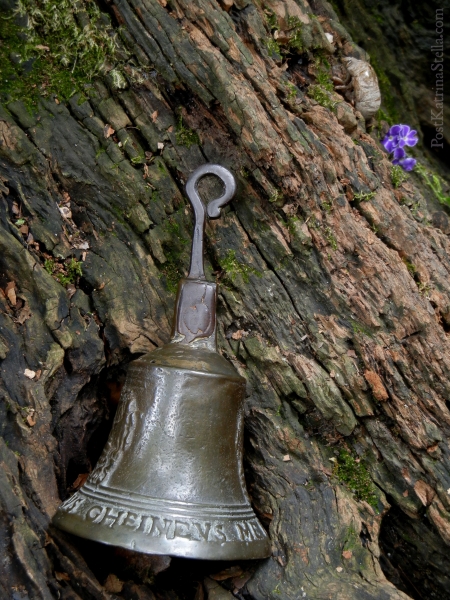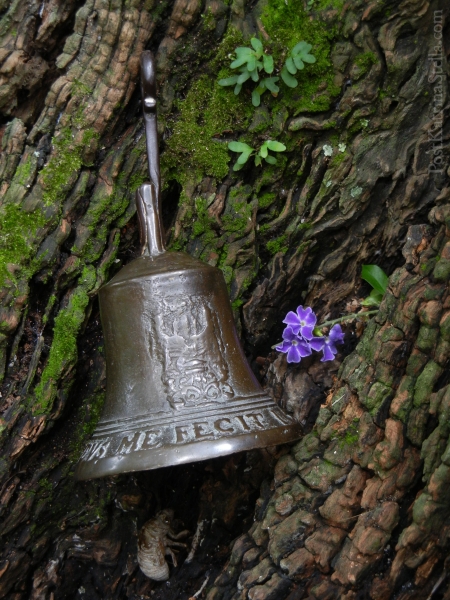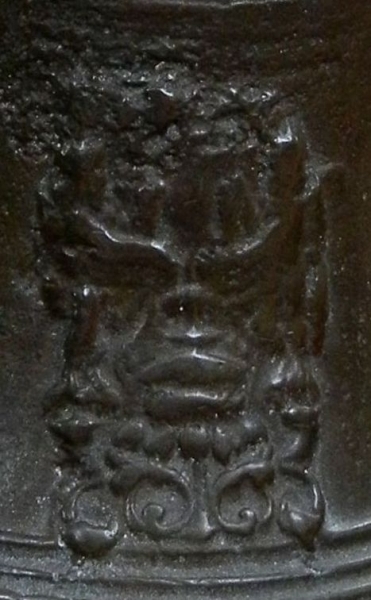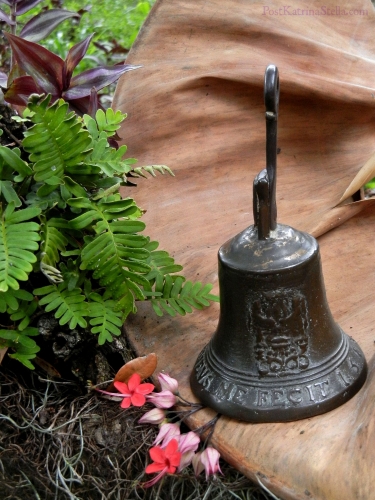
How or whether this piece will end up in a found-art piece I don’t know. It merits being showcased by itself.
So the story goes, my Dad and a school friend found this old bronze bell in a cave when they were kids, back in the early 40s, looking for voodoo stuff up in the hills above Port-au-Prince, Haiti. They shared ownership of it as they each grew up, trading it back and forth between each other’s houses until my dad returned to his family’s native Louisiana for college and became a lawyer, and Eddie went back to his native Honduras and went to work for Standard Fruit. When Eddie got married, though, his wife was superstitious of it and wouldn’t let it in the house, and this is how it came to be that, by the time I was born, it never again left our living room shelf.
I have several things of my father’s which illustrate the exotic life he had growing up in Dominican Republic and Haiti, and they will certainly make for some fun creativity. But this bell… I wonder whether I should make the kind of piece that just showcases it, rather than include it in an assemblage where it will just get lost.

It is bronze, and quite thick, a hand bell about 6 ½ inches tall with raised letters around the base, PETRVS GHEINEVS ME FECIT 1583, which is Latin for “Peter of Ghent made me – 1583”. Several specialists have told us that the repair of the handle, most likely wooden originally, was done with a ship’s nail around the same time period, and actually adds to its interest. My dad must have tried to get into Antiques Roadshow with his bell, because I found the provenance he wrote up for it.
“Eddie and I were exploring the lower foothills of a mountain range behind his home in Port-au-Prince, Haiti in about 1944-45. We were about 12-13 years old. We discovered a small cave, deep in bat dust, and inside we found several miscellaneous items, including this bell. The bell was totally encrusted with hardened foreign matter. My mother had the housekeeper’s son spend several days chipping away the matter and cleaning the bell. Since that time, the bell has been in the possession of Eddie or myself.”

.
Eddie’s version brings the story a bit more to life.
“… We paid the little kid on Tourgeau [up in the hills above Port-au-Prince], whose only garment was the shirt he had been clothed in at birth, cinquant centimes to guide us to a cave where voodoo paraphernalia was hidden. The cave was so full of bats that every stone shot from a slingshot dropped one of the bats clinging to the roof of the cave. Initially, I had remembered that I had stayed outside “to stand guard” since I was scared of bats, but then remembered that I used to get up on a chair to knock down bats that flew into the house with a tennis racquet – so I must have gone in too – how else would I remember the bats? We dragged the flour bags containing voodoo gear out of the darkness of the cave and into the sunshine, and selected to take with us the bayonet, the Petrus Gheinvs bell, the mustache cup, the little ouanga dolls (ribbons of white cloth folded and tied at the center to look like little human figures – to stick pins into, I imagine), the backbone bracelets (rats, bats?) and necklaces and I forget what else.

We took all this stuff to our house on Tourgeau and my mother made us throw everything away that was not metal or clay (i.e., the bell, bayonet & cup) because she was afraid the other stuff might infect us with Yaws. Billy claimed the bell because “my mother collects antiques”, but after 20 years, Billy told me to keep it for the next 20 years. Lydia hated the bell (she was scared of it, she says) and told me to give it back to Billy but for the next 50 years – not 20.
The caves were up in the steep hills above Port-au-Prince, where there was never any standing water and consequently no flies or mosquitoes (but then what did the bats eat?), so the houses had no screens or glass windows, only big shutters that you pulled in to lock at night. All the soapy bath and kitchen water got flung out, flowing out into the streets and down a little trough next to the sidewalk. Algae grew in the troughs and made them very slippery, and you could ski down the troughs to the bottom of the hill. Those were fun years!”
__________________
The morning after Katrina hit, the 17th St canal broke 3 blocks from my dad’s lakefront 3rd story condo. When I found where he had been evacuated to, his first words painted an amusing picture of him – 84, blind, stubborn, and aiming a loaded shotgun at people banging on his door from a boat below who turned out to be a Coast Guard rescue team, then being ‘adopted’ by a San Antonio church group that was treating him like a king. His second words were that he’d heard there was a terrible looting problem, and to please break into his condo and take two things home with me. He said he didn’t give a hoot about anything else, so long as those two things made it home with me. One was a heavy crystal vase that had been his mother’s. The other was this bell.
Daddy died 15 months after Katrina, and Eddie’s condolence letter prompted me to Google the name Petrvs Gheinevs, and what followed was a wild 6 hour ride on the internet across sites about Pieter van den Ghein, a 17th-century Belgian bronze bell maker, the bronze foundry that generations of his family in Belgium were famous for, the church carillons that were prized all over western Europe, Belgium’s conquest by Spain, and Spain’s exploration of Hispaniola, the Caribbean island that is today’s Dominican Republic and Haiti, etc.
Willem van den Ghein (1450-1533) established himself as a bellfounder in Mechelen, Belgium in 1506. He was the ancester of a long series of bellfounders under the name of Ghein or Gheyn until 1813, when a Gheyn daughter married a van Aerschodt and her sons continued making bells until 1943. Nearly 500 years. By 1583, Willem being deceased 50 years, his grandson, Pieter II, was running the foundry and Pieter’s son, Pieter III, was working with him. Daddy’s bell was made by one of those two but I don’t know which.
_________________

There is no mention of them making small bells like mine; only of carillons, sets of 23 or more bells in bell towers played on a keyboard from below, sometimes weighing as much as 100 tons!! So, I thought, why make these small bells? I never found a direct answer, but I found out that the Catholic king of Spain invaded Belgium in 1556, 27 years before Daddy’s bell was made, to stem a rebellion from its predominately Protestant population which was against converting to Catholicism, and kept it as a Spanish colony for 150 years. Belgians were known across Europe as the finest bell makers, and Spain would have ordered their church bells and carillons from there as a point of prestige. Small hand bells would have to have been of particular need on Spain’s ships, which were so heavily into exploring the New World. Like proto-cell phones. I can almost see a guy on a hill, one of a relay string of bell ringers stretching into the interior, ringing Daddy’s bell to call everyone who was off wandering the islands to return to ship, and then having it slip out of his hand down into the mouth of a cave. Cool, huh?
Those two boys had no idea what it was they’d found when they’d gone hunting for hidden voodoo stuff in that cave, and my dad died before I could tell him anything of the history behind those lone numbers, 1583. Last year was the first year that I applied to Antiques Roadshow. It seems their drawings are random and blind, without any knowledge of what people are bringing in to them, and I was turned down. But I’ll apply next year and every year. They can’t turn down my daddy’s bell forever.

.
.
Thank you so much for joining me. I’d love to hear your thoughts.
© postkatrinastella – All rights reserved
.
Laura this is all so fascinating. Thanks for sharing. Beautiful blog visually as well. If it were me I think I would preserve the bell as a singular artifact. It might be fun to make a case for it that illustrated in carving or pictures your father’s and the bell’s history.